Enigma machine
The Enigma machine is an encryption device developed and used in the early- to mid-20th century to protect commercial, diplomatic and military communication. It was employed extensively by Nazi Germany during World War II, in all branches of the German military.
_-_Museo_scienza_e_tecnologia_Milano.jpg)
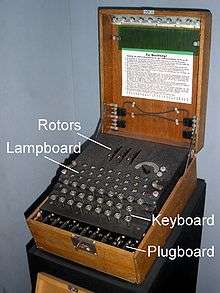
| The Enigma cipher machine |
|---|
Enigma has an electromechanical rotor mechanism that scrambles the 26 letters of the alphabet. In typical use, one person enters text on the Enigma's keyboard and another person writes down which of 26 lights above the keyboard lights up at each key press. If plain text is entered, the lit-up letters are the encoded ciphertext. Entering ciphertext transforms it back into readable plaintext. The rotor mechanism changes the electrical connections between the keys and the lights with each keypress. The security of the system depends on a set of machine settings that were generally changed daily during the war, based on secret key lists distributed in advance, and on other settings that were changed for each message. The receiving station has to know and use the exact settings employed by the transmitting station to successfully decrypt a message.
While Germany introduced a series of improvements to Enigma over the years, and these hampered decryption efforts to varying degrees, they did not ultimately prevent Britain and its allies from exploiting Enigma-encoded messages as a major source of intelligence during the war. Many commentators say the flow of communications intelligence from Ultra's decryption of Enigma, Lorenz and other ciphers shortened the war significantly and may even have altered its outcome.[1]
History
The Enigma machine was invented by the German engineer Arthur Scherbius at the end of World War I.[2] The German firm Scherbius & Ritter, co-founded by Arthur Scherbius, patented ideas for a cipher machine in 1918 and began marketing the finished product under the brand name Enigma in 1923, initially targeted at commercial markets.[3] Early models were used commercially from the early 1920s, and adopted by military and government services of several countries, most notably Nazi Germany before and during World War II.[4]
Several different Enigma models were produced, but the German military models, having a plugboard, were the most complex. Japanese and Italian models were also in use. With its adoption (in slightly modified form) by the German Navy in 1926 and the German Army and Air Force soon after, the name Enigma became widely known in military circles. Pre-war German military planning emphasized fast, mobile forces and tactics, later known as blitzkrieg, which depend on radio communication for command and coordination. Since adversaries would likely intercept radio signals, messages would have to be protected with secure encoding. Compact and easily portable, the Enigma machine filled that need.
Breaking Enigma
Around December 1932, Marian Rejewski, a Polish mathematician and cryptanalyst, while working at the Polish Cipher Bureau, used the theory of permutations and flaws in the German military message encipherment procedures to break the message keys of the plugboard Enigma machine. Rejewski achieved this result without knowledge of the wiring of the machine, so the result did not allow the Poles to decrypt actual messages. The French spy Hans-Thilo Schmidt obtained access to German cipher materials that included the daily keys used in September and October 1932. Those keys included the plugboard settings. The French passed the material to the Poles, and Rejewski used some of that material and the message traffic in September and October to solve for the unknown rotor wiring. Consequently, the Polish mathematicians were able to build their own Enigma machines, which were called Enigma doubles. Rejewski was aided by cryptanalysts Jerzy Różycki and Henryk Zygalski, both of whom had been recruited with Rejewski from Poznań University. The Polish Cipher Bureau developed techniques to defeat the plugboard and find all components of the daily key, which enabled the Cipher Bureau to read German Enigma messages starting from January 1933. Over time, the German cryptographic procedures improved, and the Cipher Bureau developed techniques and designed mechanical devices to continue reading Enigma traffic. As part of that effort, the Poles exploited quirks of the rotors, compiled catalogues, built a cyclometer to help make a catalogue with 100,000 entries, invented and produced Zygalski sheets and built the electro-mechanical cryptologic bomba to search for rotor settings. In 1938, the Germans added complexity to the Enigma machines, leading to a situation that became too expensive for the Poles to counter. The Poles had six such bomby (plural of bomba), but when the Germans added two more rotors, ten times as many bomby were then needed, and the Poles did not have the resources.[5]
On 26 and 27 July 1939,[6] in Pyry near Warsaw, the Poles initiated French and British military intelligence representatives into their Enigma-decryption techniques and equipment, including Zygalski sheets and the cryptologic bomb, and promised each delegation a Polish-reconstructed Enigma. The demonstration represented a vital basis for the later British continuation and effort.
In September 1939, British Military Mission 4, which included Colin Gubbins and Vera Atkins, went to Poland to evacuate code-breakers Gwido Langer, Marian Rejewski, Jerzy Różycki and Henryk Zygalski from the country with their replica Enigma machines. The Poles were taken across the border into Atkins' native Romania, at the time a neutral country where some of them were interned. Atkins arranged for their release and onward travel to Western Europe to advise the French and British, who at the time were still unable to decrypt German messages.[7]
Gordon Welchman, who became head of Hut 6 at Bletchley Park, has written: "Hut 6 Ultra would never have gotten off the ground if we had not learned from the Poles, in the nick of time, the details both of the German military version of the commercial Enigma machine, and of the operating procedures that were in use."[8]
During the war, British cryptologists decrypted a vast number of messages enciphered on Enigma. The intelligence gleaned from this source, codenamed "Ultra" by the British, was a substantial aid to the Allied war effort.[9]
Though Enigma had some cryptographic weaknesses, in practice it was German procedural flaws, operator mistakes, failure to systematically introduce changes in encipherment procedures, and Allied capture of key tables and hardware that, during the war, enabled Allied cryptologists to succeed and "turned the tide" in the Allies' favour.[10][11]
Etymology
The word enigma is the Latin word for riddle, derived from the Ancient Greek word aínigma (αίνιγμα) used in English, but not native German.
Design
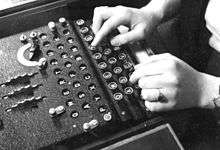
Like other rotor machines, the Enigma machine is a combination of mechanical and electrical subsystems. The mechanical subsystem consists of a keyboard; a set of rotating disks called rotors arranged adjacently along a spindle; one of various stepping components to turn at least one rotor with each key press, and a series of lamps, one for each letter.
Electrical pathway
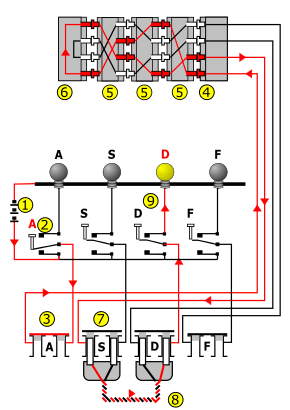
The mechanical parts act by forming a varying electrical circuit. When a key is pressed, one or more rotors rotate on the spindle. On the sides of the rotors are a series of electrical contacts that, after rotation, line up with contacts on the other rotors or fixed wiring on either end of the spindle. When the rotors are properly aligned, each key on the keyboard is connected to a unique electrical pathway through the series of contacts and internal wiring. Current, typically from a battery, flows through the pressed key, into the newly configured set of circuits and back out again, ultimately lighting one display lamp, which shows the output letter. For example, when encrypting a message starting ANX..., the operator would first press the A key, and the Z lamp might light, so Z would be the first letter of the ciphertext. The operator would next press N, and then X in the same fashion, and so on.
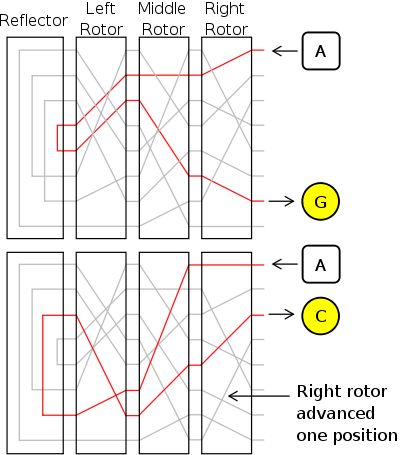
Current flows from the battery (1) through a depressed bi-directional keyboard switch (2) to the plugboard (3). Next, it passes through the (unused in this instance, so shown closed) plug "A" (3) via the entry wheel (4), through the wiring of the three (Wehrmacht Enigma) or four (Kriegsmarine M4 and Abwehr variants) installed rotors (5), and enters the reflector (6). The reflector returns the current, via an entirely different path, back through the rotors (5) and entry wheel (4), proceeding through plug "S" (7) connected with a cable (8) to plug "D", and another bi-directional switch (9) to light the appropriate lamp.[12]
The repeated changes of electrical path through an Enigma scrambler implement a polyalphabetic substitution cipher that provides Enigma's security. The diagram on the right shows how the electrical pathway changes with each key depression, which causes rotation of at least the right-hand rotor. Current passes into the set of rotors, into and back out of the reflector, and out through the rotors again. The greyed-out lines are other possible paths within each rotor; these are hard-wired from one side of each rotor to the other. The letter A encrypts differently with consecutive key presses, first to G, and then to C. This is because the right-hand rotor steps (rotates one position) on each key press, sending the signal on a completely different route. Eventually other rotors step with a key press.
Rotors
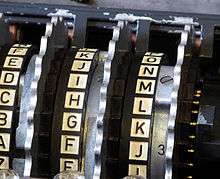
The rotors (alternatively wheels or drums, Walzen in German) form the heart of an Enigma machine. Each rotor is a disc approximately 10 cm (3.9 in) in diameter made from Ebonite or Bakelite with 26 brass, spring-loaded, electrical contact pins arranged in a circle on one face, with the other face housing 26 corresponding electrical contacts in the form of circular plates. The pins and contacts represent the alphabet — typically the 26 letters A–Z, as will be assumed for the rest of this description. When the rotors are mounted side-by-side on the spindle, the pins of one rotor rest against the plate contacts of the neighbouring rotor, forming an electrical connection. Inside the body of the rotor, 26 wires connect each pin on one side to a contact on the other in a complex pattern. Most of the rotors are identified by Roman numerals, and each issued copy of rotor I, for instance, is wired identically to all others. The same is true for the special thin beta and gamma rotors used in the M4 naval variant.
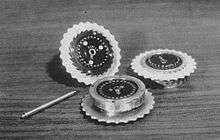
By itself, a rotor performs only a very simple type of encryption, a simple substitution cipher. For example, the pin corresponding to the letter E might be wired to the contact for letter T on the opposite face, and so on. Enigma's security comes from using several rotors in series (usually three or four) and the regular stepping movement of the rotors, thus implementing a polyalphabetic substitution cipher.
Each rotor can be set to one of 26 possible starting positions when placed in an Enigma machine. After insertion, a rotor can be turned to the correct position by hand, using the grooved finger-wheel which protrudes from the internal Enigma cover when closed. In order for the operator to know the rotor's position, each has an alphabet tyre (or letter ring) attached to the outside of the rotor disc, with 26 characters (typically letters); one of these is visible through the window for that slot in the cover, thus indicating the rotational position of the rotor. In early models, the alphabet ring was fixed to the rotor disc. A later improvement was the ability to adjust the alphabet ring relative to the rotor disc. The position of the ring was known as the Ringstellung ("ring setting"), and that setting was a part of the initial setup needed prior to an operating session. In modern terms it was a part of the initialization vector.
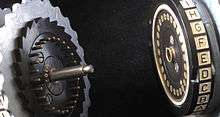
Each rotor contains one or more notches that control rotor stepping. In the military variants, the notches are located on the alphabet ring.
The Army and Air Force Enigmas were used with several rotors, initially three. On 15 December 1938, this changed to five, from which three were chosen for a given session. Rotors were marked with Roman numerals to distinguish them: I, II, III, IV and V, all with single notches located at different points on the alphabet ring. This variation was probably intended as a security measure, but ultimately allowed the Polish Clock Method and British Banburismus attacks.
The Naval version of the Wehrmacht Enigma had always been issued with more rotors than the other services: At first six, then seven, and finally eight. The additional rotors were marked VI, VII and VIII, all with different wiring, and had two notches, resulting in more frequent turnover. The four-rotor Naval Enigma (M4) machine accommodated an extra rotor in the same space as the three-rotor version. This was accomplished by replacing the original reflector with a thinner one and by adding a thin fourth rotor. That fourth rotor was one of two types, Beta or Gamma, and never stepped, but could be manually set to any of 26 positions. One of the 26 made the machine perform identically to the three-rotor machine.
Stepping
To avoid merely implementing a simple (solvable) substitution cipher, every key press caused one or more rotors to step by one twenty-sixth of a full rotation, before the electrical connections were made. This changed the substitution alphabet used for encryption, ensuring that the cryptographic substitution was different at each new rotor position, producing a more formidable polyalphabetic substitution cipher. The stepping mechanism varied slightly from model to model. The right-hand rotor stepped once with each keystroke, and other rotors stepped less frequently.
Turnover
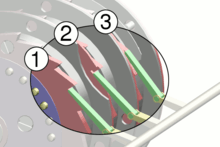
The advancement of a rotor other than the left-hand one was called a turnover by the British. This was achieved by a ratchet and pawl mechanism. Each rotor had a ratchet with 26 teeth and every time a key was pressed, the set of spring-loaded pawls moved forward in unison, trying to engage with a ratchet. The alphabet ring of the rotor to the right normally prevented this. As this ring rotated with its rotor, a notch machined into it would eventually align itself with the pawl, allowing it to engage with the ratchet, and advance the rotor on its left. The right-hand pawl, having no rotor and ring to its right, stepped its rotor with every key depression.[13] For a single-notch rotor in the right-hand position, the middle rotor stepped once for every 26 steps of the right-hand rotor. Similarly for rotors two and three. For a two-notch rotor, the rotor to its left would turn over twice for each rotation.
The first five rotors to be introduced (I–V) contained one notch each, while the additional naval rotors VI, VII and VIII each had two notches. The position of the notch on each rotor was determined by the letter ring which could be adjusted in relation to the core containing the interconnections. The points on the rings at which they caused the next wheel to move were as follows.[14]
| Rotor | Turnover position(s) | BP mnemonic |
|---|---|---|
| I | R | Royal |
| II | F | Flags |
| III | W | Wave |
| IV | K | Kings |
| V | A | Above |
| VI, VII and VIII | A and N |
The design also included a feature known as double-stepping. This occurred when each pawl aligned with both the ratchet of its rotor and the rotating notched ring of the neighbouring rotor. If a pawl engaged with a ratchet through alignment with a notch, as it moved forward it pushed against both the ratchet and the notch, advancing both rotors. In a three-rotor machine, double-stepping affected rotor two only. If in moving forward the ratchet of rotor three was engaged, rotor two would move again on the subsequent keystroke, resulting in two consecutive steps. Rotor two also pushes rotor one forward after 26 steps, but since rotor one moves forward with every keystroke anyway, there is no double-stepping.[13] This double-stepping caused the rotors to deviate from odometer-style regular motion.
With three wheels and only single notches in the first and second wheels, the machine had a period of 26×25×26 = 16,900 (not 26×26×26, because of double-stepping).[13] Historically, messages were limited to a few hundred letters, and so there was no chance of repeating any combined rotor position during a single session, denying cryptanalysts valuable clues.
To make room for the Naval fourth rotors, the reflector was made much thinner. The fourth rotor fitted into the space made available. No other changes were made, which eased the changeover. Since there were only three pawls, the fourth rotor never stepped, but could be manually set into one of 26 possible positions.
A device that was designed, but not implemented before the war's end, was the Lückenfüllerwalze (gap-fill wheel) that implemented irregular stepping. It allowed field configuration of notches in all 26 positions. If the number of notches was a relative prime of 26 and the number of notches were different for each wheel, the stepping would be more unpredictable. Like the Umkehrwalze-D it also allowed the internal wiring to be reconfigured.[15]
Entry wheel
The current entry wheel (Eintrittswalze in German), or entry stator, connects the plugboard to the rotor assembly. If the plugboard is not present, the entry wheel instead connects the keyboard and lampboard to the rotor assembly. While the exact wiring used is of comparatively little importance to security, it proved an obstacle to Rejewski's progress during his study of the rotor wirings. The commercial Enigma connects the keys in the order of their sequence on a QWERTZ keyboard: Q→A, W→B, E→C and so on. The military Enigma connects them in straight alphabetical order: A→A, B→B, C→C, and so on. It took inspired guesswork for Rejewski to penetrate the modification.
Reflector
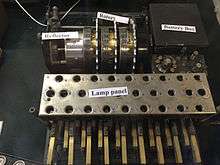
With the exception of models A and B, the last rotor came before a 'reflector' (German: Umkehrwalze, meaning 'reversal rotor'), a patented feature unique to Enigma among the period's various rotor machines. The reflector connected outputs of the last rotor in pairs, redirecting current back through the rotors by a different route. The reflector ensured that Enigma would be self-reciprocal; thus, with two identically configured machines, a message could be encrypted on one and decrypted on the other, without the need for a bulky mechanism to switch between encryption and decryption modes. The reflector allowed a more compact design, but it also gave Enigma the property that no letter ever encrypted to itself. This was a severe cryptological flaw that was subsequently exploited by codebreakers.
In Model 'C', the reflector could be inserted in one of two different positions. In Model 'D', the reflector could be set in 26 possible positions, although it did not move during encryption. In the Abwehr Enigma, the reflector stepped during encryption in a manner similar to the other wheels.
In the German Army and Air Force Enigma, the reflector was fixed and did not rotate; there were four versions. The original version was marked 'A', and was replaced by Umkehrwalze B on 1 November 1937. A third version, Umkehrwalze C was used briefly in 1940, possibly by mistake, and was solved by Hut 6.[16] The fourth version, first observed on 2 January 1944, had a rewireable reflector, called Umkehrwalze D, nick-named Uncle Dick by the British, allowing the Enigma operator to alter the connections as part of the key settings.
Plugboard

The plugboard (Steckerbrett in German) permitted variable wiring that could be reconfigured by the operator (visible on the front panel of Figure 1; some of the patch cords can be seen in the lid). It was introduced on German Army versions in 1930, and was soon adopted by the Reichsmarine (German Navy). The plugboard contributed more cryptographic strength than an extra rotor. Enigma without a plugboard (known as unsteckered Enigma) could be solved relatively straightforwardly using hand methods; these techniques were generally defeated by the plugboard, driving Allied cryptanalysts to develop special machines to solve it.
A cable placed onto the plugboard connected letters in pairs; for example, E and Q might be a steckered pair. The effect was to swap those letters before and after the main rotor scrambling unit. For example, when an operator pressed E, the signal was diverted to Q before entering the rotors. Up to 13 steckered pairs might be used at one time, although only 10 were normally used.
Current flowed from the keyboard through the plugboard, and proceeded to the entry-rotor or Eintrittswalze. Each letter on the plugboard had two jacks. Inserting a plug disconnected the upper jack (from the keyboard) and the lower jack (to the entry-rotor) of that letter. The plug at the other end of the crosswired cable was inserted into another letter's jacks, thus switching the connections of the two letters.
Accessories
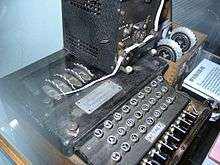
Other features made various Enigma machines more secure or more convenient.[17]
Schreibmax
Some M4 Enigmas used the Schreibmax, a small printer that could print the 26 letters on a narrow paper ribbon. This eliminated the need for a second operator to read the lamps and transcribe the letters. The Schreibmax was placed on top of the Enigma machine and was connected to the lamp panel. To install the printer, the lamp cover and light bulbs had to be removed. It improved both convenience and operational security; the printer could be installed remotely such that the signal officer operating the machine no longer had to see the decrypted plaintext.
Fernlesegerät
Another accessory was the remote lamp panel Fernlesegerät. For machines equipped with the extra panel, the wooden case of the Enigma was wider and could store the extra panel. A lamp panel version could be connected afterwards, but that required, as with the Schreibmax, that the lamp panel and light bulbs be removed.[12] The remote panel made it possible for a person to read the decrypted plaintext without the operator seeing it.
Uhr
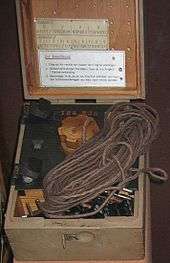
In 1944, the Luftwaffe introduced a plugboard switch, called the Uhr (clock), a small box containing a switch with 40 positions. It replaced the standard plugs. After connecting the plugs, as determined in the daily key sheet, the operator turned the switch into one of the 40 positions, each producing a different combination of plug wiring. Most of these plug connections were, unlike the default plugs, not pair-wise.[12] In one switch position, the Uhr did not swap letters, but simply emulated the 13 stecker wires with plugs.
Mathematical analysis
The Enigma transformation for each letter can be specified mathematically as a product of permutations.[18] Assuming a three-rotor German Army/Air Force Enigma, let P denote the plugboard transformation, U denote that of the reflector, and L, M, R denote those of the left, middle and right rotors respectively. Then the encryption E can be expressed as
After each key press, the rotors turn, changing the transformation. For example, if the right-hand rotor R is rotated n positions, the transformation becomes
where ρ is the cyclic permutation mapping A to B, B to C, and so forth. Similarly, the middle and left-hand rotors can be represented as j and k rotations of M and L. The encryption transformation can then be described as
Combining three rotors from a set of five, each of the 3 rotor settings with 26 positions, and the plugboard with ten pairs of letters connected, the military Enigma has 158,962,555,217,826,360,000 different settings (nearly 159 quintillion or about 67 bits).[19]
Note that (5x4x3) x (26^3) x [26! / (6! x 10! x 2^10)] = 158,962,555,217,826,360,000 ≈ 267.1
Operation
Basic operation
A German Enigma operator would be given a plaintext message to encrypt. After setting up his machine, he would type the message on the Enigma keyboard. For each letter pressed, one lamp lit indicating a different letter according to a pseudo-random substitution determined by the electrical pathways inside the machine. The letter indicated by the lamp would be recorded, typically by a second operator, as the cyphertext letter. The action of pressing a key also moved one or more rotors so that the next key press used a different electrical pathway, and thus a different substitution would occur even if the same plaintext letter were entered again. For each key press there was rotation of at least the right hand rotor and less often the other two, resulting in a different substitution alphabet being used for every letter in the message. This process continued until the message was completed. The cyphertext recorded by the second operator would then be transmitted, usually by radio in Morse code, to an operator of another Enigma machine. This operator would type in the cyphertext and — as long as all the settings of the deciphering machine were identical to those of the enciphering machine — for every key press the reverse substitution would occur and the plaintext message would emerge.
Details
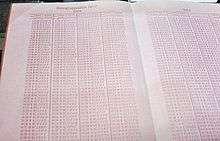
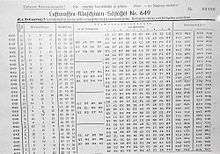
In use, the Enigma required a list of daily key settings and auxiliary documents. In German military practice, communications were divided into separate networks, each using different settings. These communication nets were termed keys at Bletchley Park, and were assigned code names, such as Red, Chaffinch, and Shark. Each unit operating in a network was given the same settings list for its Enigma, valid for a period of time. The procedures for German Naval Enigma were more elaborate and more secure than those in other services and employed auxiliary codebooks. Navy codebooks were printed in red, water-soluble ink on pink paper so that they could easily be destroyed if they were endangered or if the vessel was sunk.
An Enigma machine's setting (its cryptographic key in modern terms; Schlüssel in German) specified each operator-adjustable aspect of the machine:
- Wheel order (Walzenlage) – the choice of rotors and the order in which they are fitted.
- Ring settings (Ringstellung) – the position of each alphabet ring relative to its rotor wiring.
- Plug connections (Steckerverbindungen) – the pairs of letters in the plugboard that are connected together.
- In very late versions, the wiring of the reconfigurable reflector.
- Starting position of the rotors (Grundstellung) – chosen by the operator, should be different for each message.
For a message to be correctly encrypted and decrypted, both sender and receiver had to configure their Enigma in the same way; rotor selection and order, ring positions, plugboard connections and starting rotor positions must be identical. Except for the starting positions, these settings were established beforehand, distributed in key lists and changed daily. For example, the settings for the 18th day of the month in the German Luftwaffe Enigma key list number 649 (see image) were as follows:
- Wheel order: IV, II, V
- Ring settings: 15, 23, 26
- Plugboard connections: EJ OY IV AQ KW FX MT PS LU BD
- Reconfigurable reflector wiring: IU AS DV GL FT OX EZ CH MR KN BQ PW
- Indicator groups: lsa zbw vcj rxn
Enigma was designed to be secure even if the rotor wiring was known to an opponent, although in practice considerable effort protected the wiring configuration. If the wiring is secret, the total number of possible configurations has been calculated to be around 3×10114 (approximately 380 bits); with known wiring and other operational constraints, this is reduced to around 1023 (76 bits).[20] Because of the large number of possibilities, users of Enigma were confident of its security; it was not then feasible for an adversary to even begin to try a brute-force attack.
Indicator
Most of the key was kept constant for a set time period, typically a day. A different initial rotor position was used for each message, a concept similar to an initialisation vector in modern cryptography. The reason is that encrypting many messages with identical or near-identical settings (termed in cryptanalysis as being in depth), would enable an attack using a statistical procedure such as Friedman's Index of coincidence.[21] The starting position for the rotors was transmitted just before the ciphertext, usually after having been enciphered. The exact method used was termed the indicator procedure. Design weakness and operator sloppiness in these indicator procedures were two of the main weaknesses that made cracking Enigma possible.
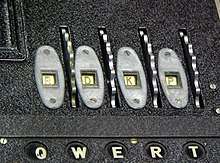
One of the earliest indicator procedures for the Enigma was cryptographically flawed and allowed Polish cryptanalysts to make the initial breaks into the plugboard Enigma. The procedure had the operator set his machine in accordance with the secret settings that all operators on the net shared. The settings included an initial position for the rotors (the Grundstellung), say, AOH. The operator turned his rotors until AOH was visible through the rotor windows. At that point, the operator chose his own arbitrary starting position for the message he would send. An operator might select EIN, and that became the message setting for that encryption session. The operator then typed EIN into the machine twice, this producing the encrypted indicator, for example XHTLOA. This was then transmitted, at which point the operator would turn the rotors to his message settings, EIN in this example, and then type the plaintext of the message.
At the receiving end, the operator set the machine to the initial settings (AOH) and typed in the first six letters of the message (XHTLOA). In this example, EINEIN emerged on the lamps, so the operator would learn the message setting that the sender used to encrypt this message. The receiving operator would set his rotors to EIN, type in the rest of the ciphertext, and get the deciphered message.
This indicator scheme had two weaknesses. First, the use of a global initial position (Grundstellung) meant all message keys used the same polyalphabetic substitution. In later indicator procedures, the operator selected his initial position for encrypting the indicator and sent that initial position in the clear. The second problem was the repetition of the indicator, which was a serious security flaw. The message setting was encoded twice, resulting in a relation between first and fourth, second and fifth, and third and sixth character. These security flaws enabled the Polish Cipher Bureau to break into the pre-war Enigma system as early as 1932. The early indicator procedure was subsequently described by German cryptanalysts as the "faulty indicator technique".[22]
During World War II, codebooks were only used each day to set up the rotors, their ring settings and the plugboard. For each message, the operator selected a random start position, let's say WZA, and a random message key, perhaps SXT. He moved the rotors to the WZA start position and encoded the message key SXT. Assume the result was UHL. He then set up the message key, SXT, as the start position and encrypted the message. Next, he transmitted the start position, WZA, the encoded message key, UHL, and then the ciphertext. The receiver set up the start position according to the first trigram, WZA, and decoded the second trigram, UHL, to obtain the SXT message setting. Next, he used this SXT message setting as the start position to decrypt the message. This way, each ground setting was different and the new procedure avoided the security flaw of double encoded message settings.[23]
This procedure was used by Wehrmacht and Luftwaffe only. The Kriegsmarine procedures on sending messages with the Enigma were far more complex and elaborate. Prior to encryption the message was encoded using the Kurzsignalheft code book. The Kurzsignalheft contained tables to convert sentences into four-letter groups. A great many choices were included, for example, logistic matters such as refuelling and rendezvous with supply ships, positions and grid lists, harbour names, countries, weapons, weather conditions, enemy positions and ships, date and time tables. Another codebook contained the Kenngruppen and Spruchschlüssel: the key identification and message key.[24]
Additional details
The Army Enigma machine used only the 26 alphabet characters. Punctuation was replaced with rare character combinations. A space was omitted or replaced with an X. The X was generally used as full-stop.
Some punctuation marks were different in other parts of the armed forces. The Wehrmacht replaced a comma with ZZ and the question mark with FRAGE or FRAQ.
The Kriegsmarine replaced the comma with Y and the question mark with UD. The combination CH, as in "Acht" (eight) or "Richtung" (direction), was replaced with Q (AQT, RIQTUNG). Two, three and four zeros were replaced with CENTA, MILLE and MYRIA.
The Wehrmacht and the Luftwaffe transmitted messages in groups of five characters.
The Kriegsmarine, using the four rotor Enigma, had four-character groups. Frequently used names or words were varied as much as possible. Words like Minensuchboot (minesweeper) could be written as MINENSUCHBOOT, MINBOOT, MMMBOOT or MMM354. To make cryptanalysis harder, messages were limited to 250 characters. Longer messages were divided into several parts, each using a different message key.[25][26]
Example encoding process
The character substitutions by the Enigma machine as a whole can be expressed as a string of letters with each position occupied by the character that will replace the character at the corresponding position in the alphabet. For example, a given machine configuration that encoded A to L, B to U, C to S, ..., and Z to J could be represented compactly as
LUSHQOXDMZNAIKFREPCYBWVGTJ
and the encoding of a particular character by that configuration could be represented by highlighting the encoded character as in
D > LUS(H)QOXDMZNAIKFREPCYBWVGTJ
Since the operation of an Enigma machine encoding a message is a series of such configurations, each associated with a single character being encoded, a sequence of such representations can be used to represent the operation of the machine as it encodes a message. For example, the process of encoding the first sentence of the main body of the famous "Dönitz message"[27] to
RBBF PMHP HGCZ XTDY GAHG UFXG EWKB LKGJ
can be represented as
0001 F > KGWNT(R)BLQPAHYDVJIFXEZOCSMU CDTK 25 15 16 26 0002 O > UORYTQSLWXZHNM(B)VFCGEAPIJDK CDTL 25 15 16 01 0003 L > HLNRSKJAMGF(B)ICUQPDEYOZXWTV CDTM 25 15 16 02 0004 G > KPTXIG(F)MESAUHYQBOVJCLRZDNW CDUN 25 15 17 03 0005 E > XDYB(P)WOSMUZRIQGENLHVJTFACK CDUO 25 15 17 04 0006 N > DLIAJUOVCEXBN(M)GQPWZYFHRKTS CDUP 25 15 17 05 0007 D > LUS(H)QOXDMZNAIKFREPCYBWVGTJ CDUQ 25 15 17 06 0008 E > JKGO(P)TCIHABRNMDEYLZFXWVUQS CDUR 25 15 17 07 0009 S > GCBUZRASYXVMLPQNOF(H)WDKTJIE CDUS 25 15 17 08 0010 I > XPJUOWIY(G)CVRTQEBNLZMDKFAHS CDUT 25 15 17 09 0011 S > DISAUYOMBPNTHKGJRQ(C)LEZXWFV CDUU 25 15 17 10 0012 T > FJLVQAKXNBGCPIRMEOY(Z)WDUHST CDUV 25 15 17 11 0013 S > KTJUQONPZCAMLGFHEW(X)BDYRSVI CDUW 25 15 17 12 0014 O > ZQXUVGFNWRLKPH(T)MBJYODEICSA CDUX 25 15 17 13 0015 F > XJWFR(D)ZSQBLKTVPOIEHMYNCAUG CDUY 25 15 17 14 0016 O > FSKTJARXPECNUL(Y)IZGBDMWVHOQ CDUZ 25 15 17 15 0017 R > CEAKBMRYUVDNFLTXW(G)ZOIJQPHS CDVA 25 15 18 16 0018 T > TLJRVQHGUCXBZYSWFDO(A)IEPKNM CDVB 25 15 18 17 0019 B > Y(H)LPGTEBKWICSVUDRQMFONJZAX CDVC 25 15 18 18 0020 E > KRUL(G)JEWNFADVIPOYBXZCMHSQT CDVD 25 15 18 19 0021 K > RCBPQMVZXY(U)OFSLDEANWKGTIJH CDVE 25 15 18 20 0022 A > (F)CBJQAWTVDYNXLUSEZPHOIGMKR CDVF 25 15 18 21 0023 N > VFTQSBPORUZWY(X)HGDIECJALNMK CDVG 25 15 18 22 0024 N > JSRHFENDUAZYQ(G)XTMCBPIWVOLK CDVH 25 15 18 23 0025 T > RCBUTXVZJINQPKWMLAY(E)DGOFSH CDVI 25 15 18 24 0026 Z > URFXNCMYLVPIGESKTBOQAJZDH(W) CDVJ 25 15 18 25 0027 U > JIOZFEWMBAUSHPCNRQLV(K)TGYXD CDVK 25 15 18 26 0028 G > ZGVRKO(B)XLNEIWJFUSDQYPCMHTA CDVL 25 15 18 01 0029 E > RMJV(L)YQZKCIEBONUGAWXPDSTFH CDVM 25 15 18 02 0030 B > G(K)QRFEANZPBMLHVJCDUXSOYTWI CDWN 25 15 19 03 0031 E > YMZT(G)VEKQOHPBSJLIUNDRFXWAC CDWO 25 15 19 04 0032 N > PDSBTIUQFNOVW(J)KAHZCEGLMYXR CDWP 25 15 19 05
where the letters following each mapping are the letters that appear at the windows at that stage (the only state changes visible to the operator) and the numbers show the underlying physical position of each rotor.
The character mappings for a given configuration of the machine are in turn the result of a series of such mappings applied by each pass through a component of the machine: the encoding of a character resulting from the application of a given component's mapping serves as the input to the mapping of the subsequent component. For example, the 4th step in the encoding above can be expanded to show each of these stages using the same representation of mappings and highlighting for the encoded character:
G > ABCDEF(G)HIJKLMNOPQRSTUVWXYZ
P EFMQAB(G)UINKXCJORDPZTHWVLYS AE.BF.CM.DQ.HU.JN.LX.PR.SZ.VW
1 OFRJVM(A)ZHQNBXPYKCULGSWETDI N 03 VIII
2 (N)UKCHVSMDGTZQFYEWPIALOXRJB U 17 VI
3 XJMIYVCARQOWH(L)NDSUFKGBEPZT D 15 V
4 QUNGALXEPKZ(Y)RDSOFTVCMBIHWJ C 25 β
R RDOBJNTKVEHMLFCWZAXGYIPS(U)Q c
4 EVTNHQDXWZJFUCPIAMOR(B)SYGLK β
3 H(V)GPWSUMDBTNCOKXJIQZRFLAEY V
2 TZDIPNJESYCUHAVRMXGKB(F)QWOL VI
1 GLQYW(B)TIZDPSFKANJCUXREVMOH VIII
P E(F)MQABGUINKXCJORDPZTHWVLYS AE.BF.CM.DQ.HU.JN.LX.PR.SZ.VW
F < KPTXIG(F)MESAUHYQBOVJCLRZDNW
Here the encoding begins trivially with the first "mapping" representing the keyboard (which has no effect), followed by the plugboard, configured as AE.BF.CM.DQ.HU.JN.LX.PR.SZ.VW which has no effect on 'G', followed by the VIII rotor in the 03 position, which maps G to A, then the VI rotor in the 17 position, which maps A to N, ..., and finally the plugboard again, which maps B to F, producing the overall mapping indicated at the final step: G to F.
Models
The Enigma family included multiple designs. The earliest were commercial models dating from the early 1920s. Starting in the mid-1920s, the German military began to use Enigma, making a number of security-related changes. Various nations either adopted or adapted the design for their own cipher machines.
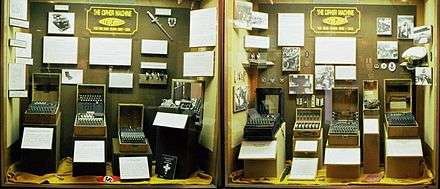 A selection of seven Enigma machines and paraphernalia exhibited at the U.S. National Cryptologic Museum. From left to right, the models are: 1) Commercial Enigma; 2) Enigma T; 3) Enigma G; 4) Unidentified; 5) Luftwaffe (Air Force) Enigma; 6) Heer (Army) Enigma; 7) Kriegsmarine (Naval) Enigma — M4. |
An estimated 100,000 Enigma machines were constructed. After the end of World War II, the Allies sold captured Enigma machines, still widely considered secure, to developing countries.[28]
Commercial Enigma
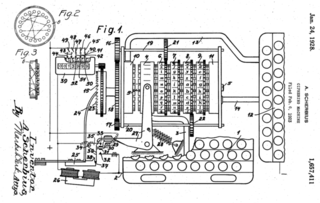
On 23 February 1918, Arthur Scherbius applied for a patent for a ciphering machine that used rotors.[29] Scherbius and E. Richard Ritter founded the firm of Scherbius & Ritter. They approached the German Navy and Foreign Office with their design, but neither agency was interested. Scherbius & Ritter then assigned the patent rights to Gewerkschaft Securitas, who founded the Chiffriermaschinen Aktien-Gesellschaft (Cipher Machines Stock Corporation) on 9 July 1923; Scherbius and Ritter were on the board of directors.
Enigma A (1923)
Chiffriermaschinen AG began advertising a rotor machine, Enigma model A, which was exhibited at the Congress of the International Postal Union in 1924. The machine was heavy and bulky, incorporating a typewriter. It measured 65×45×38 cm and weighed about 50 kilograms (110 lb).
Enigma B (1924)
In 1924 Enigma model B was introduced, and was of a similar construction.[30] While bearing the Enigma name, both models A and B were quite unlike later versions: They differed in physical size and shape, but also cryptographically, in that they lacked the reflector.
Enigma C (1926)
The reflector, suggested by Scherbius' colleague Willi Korn, was introduced in Enigma C (1926).
Model C was smaller and more portable than its predecessors. It lacked a typewriter, relying on the operator; hence the informal name of "glowlamp Enigma" to distinguish it from models A and B.
Enigma D (1927)
The Enigma C quickly gave way to Enigma D (1927). This version was widely used, with shipments to Sweden, the Netherlands, United Kingdom, Japan, Italy, Spain, United States and Poland. In 1927 Hugh Foss at the British Government Code and Cypher School was able to show that commercial Enigma machines could be broken, provided suitable cribs were available.[31]
"Navy Cipher D"
Other countries used Enigma machines. The Italian Navy adopted the commercial Enigma as "Navy Cipher D". The Spanish also used commercial Enigma machines during their Civil War. British codebreakers succeeded in breaking these machines, which lacked a plugboard.[32] Enigma machines were also used by diplomatic services.
Enigma H (1929)
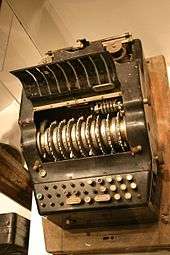
There was also a large, eight-rotor printing model, the Enigma H, called Enigma II by the Reichswehr. In 1933 the Polish Cipher Bureau detected that it was in use for high-level military communication, but it was soon withdrawn, as it was unreliable and jammed frequently.[33]
Enigma K
The Swiss used a version of Enigma called Model K or Swiss K for military and diplomatic use, which was very similar to commercial Enigma D. The machine's code was cracked by Poland, France, the United Kingdom and the United States; the latter code-named it INDIGO. An Enigma T model, code-named Tirpitz, was used by Japan.
Typex
Once the British figured out Enigma's principle of operation, they fixed the problem with it and created their own, the Typex, which the Germans believed to be unsolvable.[34]
Military Enigma
Funkschlüssel C
The Reichsmarine was the first military branch to adopt Enigma. This version, named Funkschlüssel C ("Radio cipher C"), had been put into production by 1925 and was introduced into service in 1926.[35]
The keyboard and lampboard contained 29 letters — A-Z, Ä, Ö and Ü — that were arranged alphabetically, as opposed to the QWERTZUI ordering.[36] The rotors had 28 contacts, with the letter X wired to bypass the rotors unencrypted.[11] Three rotors were chosen from a set of five[37] and the reflector could be inserted in one of four different positions, denoted α, β, γ and δ.[38] The machine was revised slightly in July 1933.[39]
Enigma G (1928–1930)
By 15 July 1928,[40] the German Army (Reichswehr) had introduced their own exclusive version of the Enigma machine, the Enigma G.
The Abwehr used the Enigma G (the Abwehr Enigma). This Enigma variant was a four-wheel unsteckered machine with multiple notches on the rotors. This model was equipped with a counter that incremented upon each key press, and so is also known as the "counter machine" or the Zählwerk Enigma.
Wehrmacht Enigma I (1930–1938)
Enigma machine G was modified to the Enigma I by June 1930.[41] Enigma I is also known as the Wehrmacht, or "Services" Enigma, and was used extensively by German military services and other government organisations (such as the railways[42]) before and during World War II.
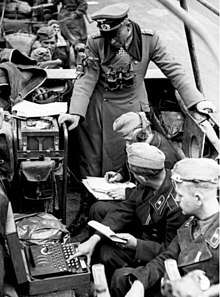
The major difference between Enigma I (German Army version from 1930), and commercial Enigma models was the addition of a plugboard to swap pairs of letters, greatly increasing cryptographic strength.
Other differences included the use of a fixed reflector and the relocation of the stepping notches from the rotor body to the movable letter rings. The machine measured 28 cm × 34 cm × 15 cm (11.0 in × 13.4 in × 5.9 in) and weighed around 12 kg (26 lb).[43]
In August 1935, the Air Force introduced the Wehrmacht Enigma for their communications.[41]
M3 (1934)
By 1930, the Reichswehr had suggested that the Navy adopt their machine, citing the benefits of increased security (with the plugboard) and easier interservice communications.[44] The Reichsmarine eventually agreed and in 1934[45] brought into service the Navy version of the Army Enigma, designated Funkschlüssel ' or M3. While the Army used only three rotors at that time, the Navy specified a choice of three from a possible five.[46]
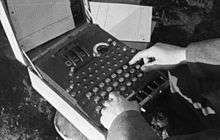
Two extra rotors (1938)
In December 1938, the Army issued two extra rotors so that the three rotors were chosen from a set of five.[41] In 1938, the Navy added two more rotors, and then another in 1939 to allow a choice of three rotors from a set of eight.[46]
M4 (1942)
A four-rotor Enigma was introduced by the Navy for U-boat traffic on 1 February 1942, called M4 (the network was known as Triton, or Shark to the Allies). The extra rotor was fitted in the same space by splitting the reflector into a combination of a thin reflector and a thin fourth rotor.
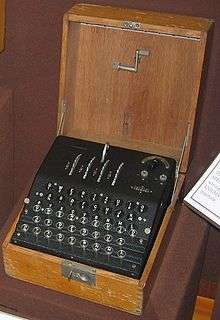 Enigma G, used by the Abwehr, had four rotors, no plugboard, and multiple notches on the rotors.
Enigma G, used by the Abwehr, had four rotors, no plugboard, and multiple notches on the rotors.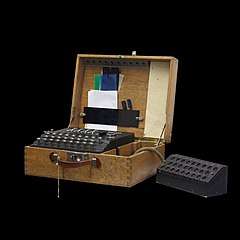 The German-made Enigma-K used by the Swiss Army had three rotors and a reflector, but no plugboard. It had locally re-wired rotors and an additional lamp panel.
The German-made Enigma-K used by the Swiss Army had three rotors and a reflector, but no plugboard. It had locally re-wired rotors and an additional lamp panel.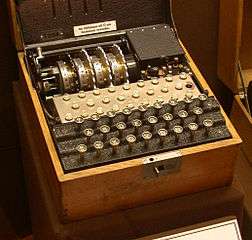 An Enigma model T (Tirpitz), a modified commercial Enigma K manufactured for use by the Japanese.
An Enigma model T (Tirpitz), a modified commercial Enigma K manufactured for use by the Japanese.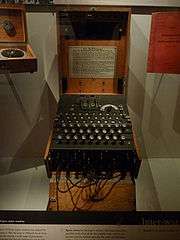 An Enigma machine in the UK's Imperial War Museum
An Enigma machine in the UK's Imperial War Museum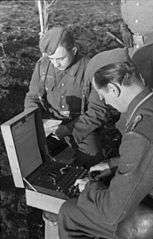 Enigma in use in Russia (image Bundesarchiv)
Enigma in use in Russia (image Bundesarchiv)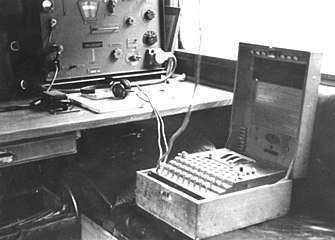 Enigma in radio car of the 7th Panzer Div. staff, August 1941
Enigma in radio car of the 7th Panzer Div. staff, August 1941
Surviving machines
_at_Discovery_Park_of_America.jpg)
The effort to break the Enigma was not disclosed until the 1970s. Since then, interest in the Enigma machine has grown. Enigmas are on public display in museums around the world, and several are in the hands of private collectors and computer history enthusiasts.[47]
The Deutsches Museum in Munich has both the three- and four-rotor German military variants, as well as several civilian versions. Enigma machines are exhibited at the National Codes Centre in Bletchley Park, the Government Communications Headquarters, the Science Museum in London, Discovery Park of America in Tennessee, the Polish Army Museum in Warsaw, the Swedish Army Museum (Armémuseum) in Stockholm, the Military Museum of A Coruña in Spain, the Nordland Red Cross War Memorial Museum in Narvik,[48] Norway, The Artillery, Engineers and Signals Museum in Hämeenlinna, Finland[49] the Technical University of Denmark in Lyngby, Denmark, in Skanderborg Bunkerne at Skanderborg, Denmark, and at the Australian War Memorial and in the foyer of the Australian Signals Directorate, both in Canberra, Australia. The Jozef Pilsudski Institute in London exhibits a rare Polish Enigma double assembled in France in 1940.[50][51]
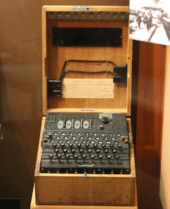
In the United States, Enigma machines can be seen at the Computer History Museum in Mountain View, California, and at the National Security Agency's National Cryptologic Museum in Fort Meade, Maryland, where visitors can try their hand at enciphering and deciphering messages. Two machines that were acquired after the capture of U-505 during World War II are on display alongside the submarine at the Museum of Science and Industry in Chicago, Illinois. A four-rotor device is on display in the ANZUS Corridor of the Pentagon on the second floor, A ring, between corridors 9 and 10. This machine is on loan from Australia. The United States Air Force Academy in Colorado Springs has a machine on display in the Computer Science Department. There is also a machine located at The National WWII Museum in New Orleans. The International Museum of World War II near Boston has seven Enigma machines on display, including a U-Boat four-rotor model, one of three surviving examples of an Enigma machine with a printer, one of fewer than ten surviving ten-rotor code machines, an example blown up by a retreating German Army unit, and two three-rotor Enigmas that visitors can operate to encode and decode messages.

In Canada, a Swiss Army issue Enigma-K, is in Calgary, Alberta. It is on permanent display at the Naval Museum of Alberta inside the Military Museums of Calgary. A four-rotor Enigma machine is on display at the Military Communications and Electronics Museum at Canadian Forces Base (CFB) Kingston in Kingston, Ontario.
Occasionally, Enigma machines are sold at auction; prices have in recent years ranged from US$40,000[52][53] to US$547,500[54] in 2017. Replicas are available in various forms, including an exact reconstructed copy of the Naval M4 model, an Enigma implemented in electronics (Enigma-E), various simulators and paper-and-scissors analogues.
A rare Abwehr Enigma machine, designated G312, was stolen from the Bletchley Park museum on 1 April 2000. In September, a man identifying himself as "The Master" sent a note demanding £25,000 and threatening to destroy the machine if the ransom was not paid. In early October 2000, Bletchley Park officials announced that they would pay the ransom, but the stated deadline passed with no word from the blackmailer. Shortly afterward, the machine was sent anonymously to BBC journalist Jeremy Paxman, missing three rotors.
In November 2000, an antiques dealer named Dennis Yates was arrested after telephoning The Sunday Times to arrange the return of the missing parts. The Enigma machine was returned to Bletchley Park after the incident. In October 2001, Yates was sentenced to ten months in prison and served three months.[55]
In October 2008, the Spanish daily newspaper El País reported that 28 Enigma machines had been discovered by chance in an attic of Army headquarters in Madrid. These four-rotor commercial machines had helped Franco's Nationalists win the Spanish Civil War, because, though the British cryptologist Alfred Dilwyn Knox in 1937 broke the cipher generated by Franco's Enigma machines, this was not disclosed to the Republicans, who failed to break the cipher. The Nationalist government continued using its 50 Enigmas into the 1950s. Some machines have gone on display in Spanish military museums,[56][57] including one at the National Museum of Science and Technology (MUNCYT) in La Coruña. Two have been given to Britain's GCHQ.[58]
The Bulgarian military used Enigma machines with a Cyrillic keyboard; one is on display in the National Museum of Military History in Sofia.[59]
Derivatives
The Enigma was influential in the field of cipher machine design, spinning off other rotor machines. The British Typex was originally derived from the Enigma patents; Typex even includes features from the patent descriptions that were omitted from the actual Enigma machine. The British paid no royalties for the use of the patents, to protect secrecy. The Typex implementation is not the same as that found in German or other Axis versions.
A Japanese Enigma clone was codenamed GREEN by American cryptographers. Little used, it contained four rotors mounted vertically. In the United States, cryptologist William Friedman designed the M-325, a machine logically similar, although not in construction.
A unique rotor machine was constructed in 2002 by Netherlands-based Tatjana van Vark. This device makes use of 40-point rotors, allowing letters, numbers and some punctuation to be used; each rotor contains 509 parts.[60]
Machines like the SIGABA, NEMA, Typex and so forth, are deliberately not considered to be Enigma derivatives as their internal ciphering functions are not mathematically identical to the Enigma transform.
Several software implementations exist, but not all exactly match Enigma behaviour. The most commonly used software derivative (that is not compliant with any hardware implementation of the Enigma) is at EnigmaCo.de. Many Java applet Enigmas only accept single letter entry, complicating use even if the applet is Enigma compliant. Technically, Enigma@home is the largest scale deployment of a software Enigma, but the decoding software does not implement encipherment making it a derivative (as all original machines could cipher and decipher).
A user-friendly three-rotor simulator, where users can select rotors, use the plugboard and define new settings for the rotors and reflectors is available.[61] The output appears in separate windows which can be independently made "invisible" to hide decryption.[62] Another includes an "autotyping" function which takes plaintext from a clipboard and converts it to cyphertext (or vice versa) at one of four speeds. The "very fast" option produces 26 characters in less than one second.[63]
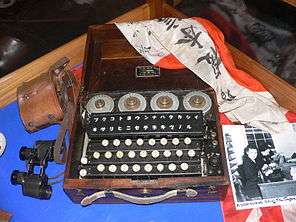 A Japanese Enigma clone, codenamed GREEN by American cryptographers.
A Japanese Enigma clone, codenamed GREEN by American cryptographers.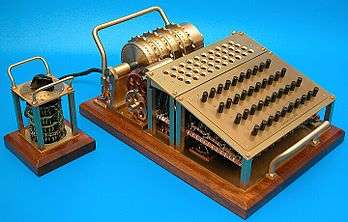 Tatjana van Vark's Enigma-inspired rotor machine.
Tatjana van Vark's Enigma-inspired rotor machine.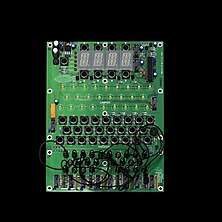 Electronic implementation of an Enigma machine, sold at the Bletchley Park souvenir shop
Electronic implementation of an Enigma machine, sold at the Bletchley Park souvenir shop
Simulators
| Name | Platform | Machine types | Uhr | UKW-D |
|---|---|---|---|---|
| Franklin Heath Enigma Simulator[64] | Android | K Railway, Kriegsmarine M3,M4 | No | No |
| EnigmAndroid[65] | Android | Wehrmacht I, Kriegsmarine M3, M4, Abwehr G31, G312, G260, D, K, Swiss-K, KD, R, T | No | No |
| Andy Carlson Enigma Applet (Standalone Version)[66] | Java | Kriegsmarine M3, M4 | No | No |
| Minarke (Minarke Is Not A Real Kriegsmarine Enigma)[67] | C/Posix/CLI (MacOS, Linux, UNIX, etc.) | Wehrmacht, Kriegsmarine, M3, M4 | No | No |
| Russell Schwager Enigma Simulator[68] | Java | Kriegsmarine M3 | No | No |
| PA3DBJ G-312 Enigma Simulator[69] | Javascript | G312 Abwehr | No | No |
| Daniel Palloks Universal Enigma[70] | Javascript | I (Wehrmacht), M3 (Kriegsmarine), M4 (Shark), D (commercial), K (Swiss), KD (Sweden), N (Norenigma), R (Railway), S (Sondermaschine), T (Tirpitz/Japan), A-865 (Zählwerk), G-111 (Hungary/Munich), G-260 (Abwehr/Argentina), G-312 (Abwehr/Bletchley Park) | Yes | Yes |
| Universal Enigma Machine Simulator[71] | Javascript | D, I, Norway, M3, M4, Zählwerk, G, G-111, G-260, G-312, K, Swiss-K, KD, Railway, T | Yes | Yes |
| Terry Long Enigma Simulator[72] | MacOS | Kriegsmarine M3 | No | No |
| Paul Reuvers Enigma Simulator for RISC OS[73] | RISC OS | Kriegsmarine M3, M4, G-312 Abwehr | No | No |
| Dirk Rijmenants Enigma Simulator v7.0[74] | Windows | Wehrmacht, Kriegsmarine M3, M4 | No | No |
| Frode Weierud Enigma Simulators[75] | Windows | Abwehr, Kriegsmarine M3, M4, Railway | No | No |
| Alexander Pukall Enigma Simulator[76] | Windows | Wehrmacht, Luftwaffe | No | No |
| CrypTool 2 — Enigma component and cryptanalysis[77] | Windows | A/B/D (commercial), Abwehr, Reichsbahn, Swiss-K, Enigma M3, Enigma M4 | No | No |
In popular culture
- Literature
- Hugh Whitemore's play, Breaking the Code (1986), focuses on the life and death of Alan Turing, who was the central force in continuing to solve the Enigma code in the United Kingdom, during World War II. Turing was played by Derek Jacobi, who also played Turing in a 1996 television adaptation of the play.
- Robert Harris' novel Enigma (1995) is set against the backdrop of World War II Bletchley Park and cryptologists working to read Naval Enigma in Hut 8.
- Neal Stephenson's novel Cryptonomicon (1999) prominently features the Enigma machine and efforts to break it, and portrays the German U-boat command under Karl Dönitz using it in apparently deliberate ignorance of its penetration.
- Enigma is featured in The Code Book, a survey of the history of cryptography written by Simon Singh and published in 1999.
- The Enigma machine is used as a key plot element in Century Rain by Alastair Reynolds, set in an alternate Earth where technological research has stagnated and the Enigma is the highest level of encryption available both to civilians and military.
- Films
- Sekret Enigmy (1979; translation: The Enigma Secret), is a Polish film dealing with Polish aspects of the subject.[78]
- The plot of the film U-571 (released in 2000) revolves around an attempt by American, rather than British, forces to seize an Enigma machine from a German U-boat.
- The 2001 war comedy film All the Queen's Men featured a fictitious British plot to capture an Engima machine by infiltrating the Enigma factory with men disguised as women.
- Harris' book, with substantial changes in plot, was adapted as the film Enigma (2001), directed by Michael Apted and starring Kate Winslet and Dougray Scott. The film was criticised for historical inaccuracies, including neglect of the role of Poland's Biuro Szyfrów. The film, like the book, makes a Pole the villain, who seeks to betray the secret of Enigma decryption.[79]
- The film The Imitation Game (2014) tells the story of Alan Turing and his attempts to crack the Enigma machine code during World War II.[47]
- Television
- In the British television series The Bletchley Circle, the Typex was used by the protagonists during the war, and in Season 2, Episode 4, they visit Bletchley Park to seek one out, in order to crack the code of the black market procurer and smuggler Marta, who used the Typex to encode her ledger. The Circle, forced to settle for using an Enigma, instead, successfully cracks the code.
- In Elementary season 5, episode 23 ("Scrambled"), a drug smuggling gang uses a four-rotor Enigma machine as part of their effort to encrypt their communications.
- In Bones season 8, episode 12 ("The Corpse in the Canopy"), Dr. Jack Hodgins uses an Enigma machine to send information to Seeley Booth at the FBI in order to prevent Christopher Pelant, a master hacker, from spying on their communications.
See also
- Beaumanor Hall, a stately home used during the Second World War for military intelligence
- Alastair Denniston
- Erich Fellgiebel
- Gisbert Hasenjaeger — responsible for Enigma security
- Erhard Maertens — investigated Enigma security
- Fritz Thiele
- United States Naval Computing Machine Laboratory
- Arlington Hall
References
- Keegan, John, Sir (2003). Intelligence in Warfare. New York: Alfred A. Knopf.
- Singh, Simon (26 January 2011). The Code Book: The Science of Secrecy from Ancient Egypt to Quantum Cryptography. Knopf Doubleday Publishing Group. ISBN 978-0-307-78784-2.
- "History of the Enigma". Crypto Museum. Retrieved 1 December 2017.
- Lord, Bob (1998–2010). "Enigma Manual". Retrieved 31 May 2011.CS1 maint: ref=harv (link)
- Kozaczuk 1984, p. 63.
- Ralph Erskine: The Poles Reveal their Secrets – Alastair Dennistons's Account of the July 1939 Meeting at Pyry. Cryptologia. Rose-Hulman Institute of Technology. Taylor & Francis, Philadelphia, Pennsylvania 30.2006,4, p. 294.
- Stevenson, William (November 2011), Spymistress: The True Story of the Greatest Female Secret Agent of World War II, Arcade Publishing, ISBN 978-1611452310
- Welchman 1982, p. 289.
- Much of the German cipher traffic was encrypted on the Enigma machine, and the term "Ultra" has often been used almost synonymously with "Enigma decrypts". Ultra also encompassed decrypts of the German Lorenz SZ 40 and 42 machines that were used by the German High Command, and decrypts of Hagelin ciphers and other Italian ciphers and codes, as well as of Japanese ciphers and codes such as Purple and JN-25.
- Kahn 1991.
- Stripp 1993.
- Rijmenants, Dirk; Technical details of the Enigma machine Cipher Machines & Cryptology
- Hamer, David (January 1997). "Enigma: Actions Involved in the 'Double-Stepping' of the Middle Rotor". Cryptologia. 21 (1): 47–50. doi:10.1080/0161-119791885779. Archived from the original (zip) on 19 July 2011.
- Sale, Tony. "Technical specifications of the Enigma rotors". Technical Specification of the Enigma. Retrieved 15 November 2009.
- "Lückenfüllerwalze". Cryptomuseum.com. Retrieved 17 July 2012.
- Philip Marks, "Umkehrwalze D: Enigma's Rewirable Reflector — Part I", Cryptologia 25(2), April 2001, pp. 101–141
- Reuvers, Paul (2008). "Enigma accessories". Retrieved 22 July 2010.
- Rejewski 1980.
- 158,962,555,217,826,360,000 — Numberphile on YouTube
- Miller, A. Ray (2001). "The Cryptographic Mathematics of Enigma" (PDF). National Security Agency. Cite journal requires
|journal=(help)CS1 maint: ref=harv (link) - Friedman, W.F. (1922). The index of coincidence and its applications in cryptology. Department of Ciphers. Publ 22. Geneva, Illinois, USA: Riverbank Laboratories. OCLC 55786052.
- Huttenhain & Fricke 1945, pp. 4,5.
- Rijmenants, Dirk; Enigma message procedures Cipher Machines & Cryptology
- Rijmenants, Dirk; Kurzsignalen on German U-boats Cipher Machines & Cryptology
- "The translated 1940 Enigma General Procedure". codesandciphers.org.uk. Retrieved 16 October 2006.
- "The translated 1940 Enigma Officer and Staff Procedure". codesandciphers.org.uk. Retrieved 16 October 2006.
- "Message from Dönitz — 1 May 1945". Retrieved 27 November 2018.
- Bauer 2000, p. 112.
- US 1657411, Scherbius, Arthur, "Ciphering Machine", issued January 24, 1928, assigned to Chiffriermaschinen AG
- "image of Enigma Type B". Archived from the original on 21 October 2005.
- Bletchley Park Trust Museum display
- Smith 2006, p. 23.
- Kozaczuk 1984, p. 28.
- Flaw in the Enigma Code — Numberphile on YouTube
- Kahn 1991, pp. 39–41, 299.
- Ulbricht 2005, p. 4.
- Kahn 1991, pp. 40, 299.
- Bauer 2000, p. 108.
- Stripp 1993, plate 3.
- Kahn 1991, pp. 41, 299.
- Kruh & Deavours 2002, p. 97.
- Smith 2000, p. 73.
- Stripp, 1993
- Kahn 1991, p. 43.
- Kahn 1991, p. 43 says August 1934. Kruh & Deavours 2002, p. 15 say October 2004.
- Kruh & Deavours 2002, p. 98.
- Ng, David. "Enigma machine from World War II finds unlikely home in Beverly Hills". Los Angeles Times. 22 January 2015.
- "War Museum".
- "The National Signals Museum".
- "Enigma exhibition in London pays tribute to Poles". Polskie Radio dla Zagranicy. Archived from the original on 23 April 2016. Retrieved 5 April 2016.
- "13 March 2016, 'Enigma Relay'– how Poles passed the baton to Brits in the run for WWII victory". pilsudski.org.uk. Archived from the original on 22 April 2016. Retrieved 5 April 2016.
- Hamer, David; Enigma machines – known locations* Archived 4 November 2011 at the Wayback Machine
- Hamer, David; Selling prices of Enigma and NEMA – all prices converted to US$ Archived 27 September 2011 at the Wayback Machine
- Christi's; 4 Rotor enigma auction
- "Man jailed over Enigma machine". BBC News. 19 October 2001. Retrieved 2 May 2010.
- Graham Keeley. Nazi Enigma machines helped General Franco in Spanish Civil War, The Times, 24 October 2008, p. 47.
- "Taller de Criptografía – Enigmas españolas". Cripto.es. Archived from the original on 11 June 2013. Retrieved 8 September 2013.
- "Schneier on Security: Rare Spanish Enigma Machine". Schneier.com. 26 March 2012. Retrieved 8 September 2013.
- "Communication equipment". znam.bg. 29 November 2003. Archived from the original on 13 January 2015. Retrieved 13 January 2015.
- van Vark, Tatjana The coding machine
- "3 rotor download".
- "Enigma at Multimania". Archived from the original on 2 April 2013. Retrieved 2 April 2013.
- "Autotype download".
- Franklin Heath Ltd. "Enigma Simulator – Android Apps on Google Play". google.com.
- "F-Droid". f-droid.org.
- Andy Carlson, Enigma Applet (Standalone Version)
- John Gilbert, Minarke – A Terminal Friendly Enigma Emulator
- Russell Schwager, Enigma Simulator Russell Schwager Enigma Simulator
- PA3DBJ G-312, Enigma Simulator
- Daniel Palloks, Universal Enigma
- Summerside Makerspace,Universal Enigma Machine Simulator
- Terry Long, Enigma Simulator
- Paul Reuvers, Enigma Simulator for RISC OS
- Dirk Rijmenants, Enigma Simulator v7.0
- Frode Weierud Enigma Simulators
- Alexander Pukall
- CrypTool 2 Team, CrypTool 2 website
- Enigma machine on IMDb
- Laurence Peter (20 July 2009). "How Poles cracked Nazi Enigma secret". BBC News.
Bibliography
- Bauer, F. L. (2000). Decrypted Secrets (2nd ed.). Springer. ISBN 978-3-540-66871-8.CS1 maint: ref=harv (link)
- Hamer, David H.; Sullivan, Geoff; Weierud, Frode (July 1998). "Enigma Variations: An Extended Family of Machines" (PDF). Cryptologia. XXII (3): 211–229. doi:10.1080/0161-119891886885. ISSN 0161-1194. Retrieved 18 February 2016.
- Stripp, Alan (1993). Hinsley, F. H.; Stripp, Alan (eds.). The Enigma Machine: Its Mechanism and Use. Codebreakers: The Inside Story of Bletchley Park.CS1 maint: ref=harv (link)
- Kahn, David (1991). Seizing the Enigma: The Race to Break the German U-Boats Codes, 1939–1943. ISBN 978-0-395-42739-2.CS1 maint: ref=harv (link)
- Kozaczuk, Władysław (1984). Kasparek, Christopher (ed.). Enigma: How the German Machine Cipher Was Broken, and How It Was Read by the Allies in World War Two. Frederick, MD: University Publications of America. ISBN 978-0-89093-547-7.CS1 maint: ref=harv (link)
- Kozaczuk, Władysław. "The origins of the Enigma/ULTRA". Archived from the original on 17 July 2003.
- Kruh, L.; Deavours, C. (2002). "The Commercial Enigma: Beginnings of Machine Cryptography". Cryptologia. 26: 1–16. doi:10.1080/0161-110291890731.CS1 maint: ref=harv (link)
- Marks, Philip; Weierud, Frode (2000). "Recovering the Wiring of Enigma's Umkehrwalze A" (PDF). Cryptologia. 24 (1): 55–66. CiteSeerX 10.1.1.622.1584. doi:10.1080/0161-110091888781. Archived from the original (PDF) on 13 February 2012.
- Rejewski, Marian (1980). "An Application of the Theory of Permutations in Breaking the Enigma Cipher". Applicationes Mathematicae. 16 (4): 543–559. doi:10.4064/am-16-4-543-559. ISSN 1730-6280.CS1 maint: ref=harv (link)
- Smith, Michael (2000). Station X: The Codebreakers of Bletchley Park. Pan. ISBN 978-0-7522-7148-4.CS1 maint: ref=harv (link)
- Smith, Michael (2006). "How it began: Bletchley Park Goes to War". In Copeland, B Jack (ed.). Colossus: The Secrets of Bletchley Park's Codebreaking Computers. Oxford: Oxford University Press. ISBN 978-0-19-284055-4.CS1 maint: ref=harv (link)
- Ulbricht, Heinz (2005). "Die Chiffriermaschine Enigma — Trügerische Sicherheit: Ein Beitrag zur Geschichte der Nachrichtendienste" [The Enigma Cipher Machine — Deceptive Security: A contribution to the history of intelligence services] (PDF). PhD Thesis (in German). Cite journal requires
|journal=(help)CS1 maint: ref=harv (link) - Welchman, Gordon (1982). The Hut Six Story: Breaking the Enigma Codes. McGraw-Hill. ISBN 978-0-07-069180-3.
Further reading
- Aldrich, Richard James (2010). GCHQ: The Uncensored Story of Britain's Most Secret Intelligence Agency. HarperPress. ISBN 978-0-00-727847-3.
- Bertrand, Gustave (1973). Enigma: ou, La plus grande énigme de la guerre 1939–1945. Plon.
- Calvocoressi, Peter (2001). Top Secret Ultra. M & M Baldwin. pp. 98–103. ISBN 978-0-947712-41-9.
- Grime, James. "Enigma – 158,962,555,217,826,360,000". Numberphile. Brady Haran. Archived from the original on 30 March 2013. Retrieved 7 April 2013.
- Grime, James. "The Enigma Flaw". Numberphile. Brady Haran. Archived from the original on 30 March 2013. Retrieved 7 April 2013.
- Heath, Nick, Hacking the Nazis: The secret story of the women who broke Hitler's codes TechRepublic, 27 March 2015
- Herivel, John (2008). Herivelismus: And the German Military Enigma. M & M Baldwin.
- Huttenhain, Orr; Fricke (1945), OKW/Chi Cryptanalytic Research on Enigma, Hagelin and Cipher Teleprinter Messages, TICOM
- Keen, John (1 August 2012). Harold 'Doc' Keen and the Bletchley Park Bombe. M & M Baldwin. ISBN 978-0-947712-48-8.
- Large, Christine (6 October 2003). Hijacking Enigma: The Insider's Tale. Wiley. ISBN 978-0-470-86346-6.
- Marks, Philip. "Umkehrwalze D: Enigma's Rewirable Reflector — Part I", Cryptologia 25(2), April 2001, pp. 101–141.
- Marks, Philip. "Umkehrwalze D: Enigma's Rewirable Reflector — Part II", Cryptologia 25(3), July 2001, pp. 177–212.
- Marks, Philip. "Umkehrwalze D: Enigma's Rewirable Reflector — Part III", Cryptologia 25(4), October 2001, pp. 296–310.
- Paillole, Paul (1985). Notre espion chez Hitler [Our Spy with Hitler] (in French). Robert Laffont.
- Perera, Tom (2010). Inside ENIGMA. Bedford, UK: Radio Society of Great Britain. ISBN 978-1-905086-64-1.
- Perera, Tom. The Story of the ENIGMA: History, Technology and Deciphering, 2nd Edition, CD-ROM, 2004, Artifax Books, ISBN 1-890024-06-6 sample pages
- Rebecca Ratcliffe: Searching for Security. The German Investigations into Enigma's security. In: Intelligence and National Security 14 (1999) Issue 1 (Special Issue) S. 146–167.
- Ratcliffe, Rebecca (1 January 2005). Winkel, Brian J. (ed.). How Statistics led the Germans to believe Enigma Secure and Why They Were Wrong: neglecting the practical Mathematics of Cipher machines. The German Enigma Cipher Machine: Beginnings, Success, and Ultimate Failure. Artech House. ISBN 978-1-58053-996-8.
- Rejewski, Marian. How Polish Mathematicians Deciphered the Enigma", Annals of the History of Computing 3, 1981. This article is regarded by Andrew Hodges, Alan Turing's biographer, as "the definitive account" (see Hodges' Alan Turing: The Enigma, Walker and Company, 2000 paperback edition, p. 548, footnote 4.5).
- Quirantes, Arturo (April 2004). "Model Z: A Numbers-Only Enigma Version". Cryptologia. 28 (2): 153–156. doi:10.1080/0161-110491892845.
- Sebag-Montefiore, Hugh (2011). Enigma: The Battle For The Code. Orion. ISBN 978-1-78022-123-6.
- Ulbricht, Heinz. Enigma Uhr, Cryptologia, 23(3), April 1999, pp. 194–205.
- Turing, Dermot (2018). X, Y & Z : the real story of how Enigma was broken. Gloustershire England: History Press. ISBN 978-0-7509-8782-0. OCLC 1029570490.CS1 maint: ref=harv (link)
- Winterbotham, F. W. (1999). The Ultra Secret. Weidenfeld & Nicolson. ISBN 978-0-297-64405-7.
External links
| Wikimedia Commons has media related to Enigma machine. |
- Gordon Corera, Poland's overlooked Enigma codebreakers, BBC News Magazine, 4 July 2014
- Long-running list of places with Enigma machines on display
- Bletchley Park National Code Centre Home of the British codebreakers during the Second World War
- Enigma machines on the Crypto Museum Web site
- Pictures of a four-rotor naval enigma, including Flash (SWF) views of the machine
- Enigma Pictures and Demonstration by NSA Employee at RSA
- Enigma machine at Curlie
- Kenngruppenheft
- Process of building an Enigma M4 replica
- Breaking German Navy Ciphers
- An online Enigma Machine simulator
- Enigma simulation
- Universal Enigma simulator
- Cryptii — Online modular playground, including 13 Enigma machine variations